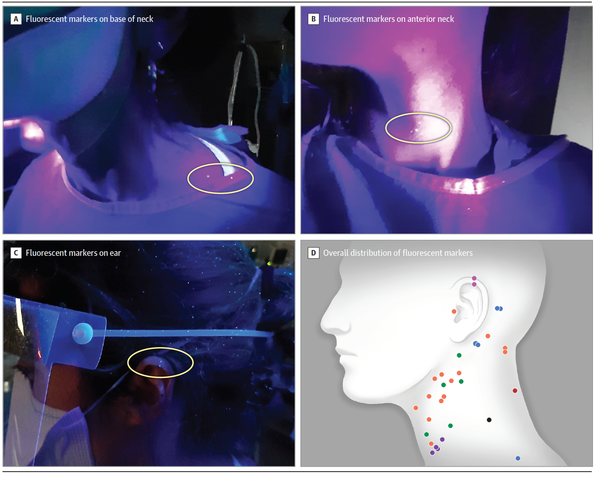Results
For each simulation (adult and child manikins), 2 physicians and 2 nurses participated (8 total participants). All participants were experienced in emergency department care and had participated in resuscitations. In the adult scenario, intubation was successful during the second videolaryngoscopic attempt. In the pediatric scenario, intubation was successful using direct laryngoscopy after 1 failed videolaryngoscopic attempt. Seven of 8 participants had fluorescent markers on their exposed skin, 6 on the neck, and 1 on an ear (Figure). All team members had fluorescent markers on their hair and 4 had markers on their shoes. During the adult and pediatric scenarios, there were 102 and 88, respectively, participant-manikin contacts.
Discussion
Despite personal protective equipment, fluorescent markers were found on the uncovered skin, hair, and shoes of participants after simulations of emergency department management of patients experiencing respiratory distress. The findings suggest that the current recommendations for personal protective equipment may not fully prevent exposures in emergency department settings. Clothing that covers all skin may further diminish exposure risk.
Inhalation of aerosols and exposure risks associated with doffing were not evaluated in this study. The small number of participants, the simulated health care setting, and the surrogate measures of exposure are the primary limitations. Because this was a simulation study using manikins, it is uncertain how the results might apply to actual patient care.
救急患者診療シミュレーションを用いた個人用保護具を着用した救急医の汚染の曝露の評価 (JAMA. 2020.4.27)
結果
各シミュレーション(成人マネキン、小児マネキン)には、医師2名、看護師2名が参加した(合計8名)。参加者は全員救急診療の経験があり、蘇生にも参加していた。成人シナリオでは、2回目のビデオ耳鼻咽喉頭鏡下手術で挿管に成功し、小児シナリオでは、2回目のビデオ耳鼻咽頭鏡下手術で挿管に成功した。小児シナリオでは、1回のビデオ喉頭鏡の試みに失敗した後、直接喉頭鏡を使用して挿管に成功した。8人の参加者のうち7人は皮膚の露出部に蛍光マーカーがあり、6人は首に、1人は耳に蛍光マーカーがあった(図)。参加者全員の髪の毛に蛍光マーカーがあり、4人は靴にマーカーがついていた。成人シナリオでは102回、小児シナリオでは88回の参加者はマネキンと接触があった。

(画像出典 jamanetwork.com https://jamanetwork.com/journals/jama/fullarticle/2765377)
考察
呼吸困難を呈した救急患者シミュレーションを行った後、個人用防護具を着用しているにもかかわらず、参加者の露出していない皮膚、髪の毛、靴から蛍光マーカーが検出された。この結果は、現在推奨されている個人用保護具では、救急外来で曝露を完全に防ぐことができない可能性があることを示唆している。すべての皮膚を覆う衣服を着用することで、曝露リスクがさらに減少する可能性がある。エアロゾルの吸入および脱着に関連する曝露リスクは、本研究では評価されなかった。参加者の数が少ないこと、シミュレーションされた医療環境、および曝露の代替手段が主な限界である。これはマネキンを用いたシミュレーション研究であるため、その結果が実際の患者ケアにどのように適用されるかは不明である。
(Smart119スタッフコメント)
通常の個人用防護具では、救急外来で曝露を完全に防ぐことができない可能性があることが示唆されている。